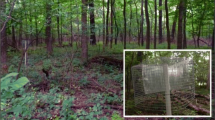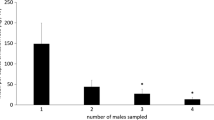Abstract
Pheromone-baited traps located close to both host and nonhost crowns were more attractive than traps located between crowns for bothC. occidentalis Freeman andC. retiniana (Walsingham) at both 10 m and at 1.5 m above the ground. At 10 m height, traps located in host foliage were more attractive than those located in nonhost foliage, but at 1.5m height there was no significant difference. These results were obtained for both dense and sparse populations ofC. occidentalis and sparse populations ofC. retiniana. We conclude that the tree species on which a virgin female is located is not an important factor restricting mating between closely relatedChoristoneura spp. Also, the tree species on which a trap is located may not be an important factor that must be standardized in developing pheromone monitoring systems forC. occidentalis andC. retiniana.
Similar content being viewed by others
References
Aliniazee, M.T., andStafford, E.M. 1972. Sex pheromone studies on the omnivorous leafroller,Platynota stultana (Lepidoptera: Tortricidae): Effect of various environmental factors on attraction of males to traps baited with virgin females.Ann. Entomol. Soc. Am. 65:958–961.
Butler, L.I., andMcDonough, L.M. 1979. Insect sex pheromones: Evaporation rates of acetates from natural rubber septa.J. Chem. Ecol. 5:825–837.
Butler, L.I., andMcdonough, L.M. 1981. Insect sex pheromones: Evaporation rates of alcohols and acetates from natural rubber septa.J. Chem. Ecol. 7:627–633.
Cardé, R.T. 1979. Behavioral responses of moths to female produced pheromones and the utilization of attractant baited traps for population monitoring, pp. 286–315in R.L. Rabb and G.G. Kennedy (eds.). Movement of Highly Mobile Insects: Concepts and Methodology in Research. North Carolina State University, Raleigh, North Carolina.
Conover, W.J. 1981. Practical Nonparametric Statistics. J. Wiley & Sons Inc., New York. 462 pp.
Cory, H.T., Daterman, G.E., Daves, G.D., Jr., Sower, L.L., Shepherd, R.F., andSanders, C.J. 1982. Chemistry and field evaluation of the sexpheromone of western spruce budworm,Choristoneura occidentalis Freeman.J. Chem. Ecol. 8:339–350.
Daterman, G.E., Robbins, R.G., Eichlin, T.D., andPierce, J. 1977. Forest Lepidoptera attracted by known sex attractants of western spruce budworms,Choristoneura spp. (Lepidoptera: Tortricidae).Can. Entomol. 109:875–878.
Daterman, G.E.,Cory, H.T.,Sower, L.L., andDaves, G.D., Jr. 1984. Sex pheromone of a conifer-feeding budworm,Choristoneura retiniana, Walsingham.J. Chem. Ecol. In press.
Dillworth, J.R., andBell, J.F. 1979. Variable probability sampling-variable plot and three-P.O.S.U. Book Stores, Inc., Corvallis, Oregon. 130 pp.
Freeman, T.N. 1967. On coniferophagous species ofChoristoneura (Lepidoptera: Tortricidae) in North America. I. Some new forms ofChoristoneura allied toC. fumiferana.Can. Entomol. 99:449–455.
Greenbank, D.O.,Schaefer, G.W., andRainey, R.C. 1980. Spruce budworm (Lepidoptera: Tortricidae) moth flight and dispersal: New understanding from canopy observations, radar, and aircraft.Mem. Entomol. Soc. Can. 110:49 pp.
Holbrook, R.F., Beroza, M., andBurgess, E.D. 1960. Gypsy moth (Ponhetria dispar) detection with the natural sex lure.J. Econ. Entomol. 53:751–756.
Houseweart, M.W., Jennings, D.T., andSanders, C.J. 1981. Variables associated with pheromone traps for monitoring spruce budworm populations (Lepidoptera: Tortricidae).Can. Entomol. 113:527–537.
Kennedy, J.S., andMarsh, D. 1974. Pheromone-regulated anemotaxis in flying moths.Science 184:999–1001.
Kleinschmidt, S.,Baskerville, G.L., andSolomon, D.S. 1980. Foliage weight distribution in the upper crown of balsam fir.USDA For. Serv. Res. Pap. NE-455. 8 pp.
Miller, C.A., andMcDougall, G.A. 1973. Spruce budworm moth trapping using virgin females.Can. J. Zool. 51:853–858.
Phillips, P.A., andBarnes, M.M. 1975. Host race formation among sympatric apple, walnut, and plum populations of the codling moth,Lasperyresia pomonella.Ann. Entomol. Soc. Am. 68:1053–1060.
Powell, J.A. 1980. Nomenclature of Nearctic conifer-feedingChoristoneura (Lepidoptera: Tortricidae): Historical review and present status.USDA For. Serv. Gen. Tech. Rep. PNW-100. 18 pp.
Rahn, R. 1977. Premiers résultats et problèmes méthedologiques concernant l'étude des rapports entre milieu trophique et son consommateur: Cas de la stimulation sexuelle d'Acrolepiopsis (Acrolepia) assectella Z. (Lep. Plutellidae) parAllium porrum, pp. 337–351,in V. Labeyrie (ed.). Comportement des insectes et milieu trophique. Colloques Internationaux du CNRS No. 265. Paris, France.
Riedl, H., Hoying, S.A., Barnett, W.W., andDeTar, J.E. 1979. Relationship of within-tree placement of the pheromone trap to codling moth catches.Environ. Entomol. 8:765–769.
Saario, C.A., Shorey, H.H., andGaston, L.K. 1970. Sex pheromones of the noctuid moths. XIX. Effect of environmental and seasonal factors on captures of males ofTrichoplusia ni in pheromone baited traps.Ann. Entomol. Soc. Am. 63:667–672.
Sanders, C.J. 1971. Daily activity patterns and sex pheromone specificity as sexual isolating mechanisms in two species ofChoristoneura (Lepidoptera: Tortricidae).Can. Entomol. 103:498–502.
Sanders, C.J. 1978. Evaluation of sex attractant traps for monitoring spruce budworm populations (Lepidoptera: Tortricidae).Can. Entomol. 110:43–50.
Sanders, C.J., Daterman, G.E., Shepherd, R.F., andCerezke, H. 1974. Sex attractants for two species of western spruce budworm,Choristoneura biennis andC. viridis (Lepidoptera: Tortricidae).Can. Entomol 106:157–159.
Sanders, C.J., Daterman, G.E., andEnnis, T.J. 1977. Sex pheromone responses ofChoristoneura spp. and their hybrids (Lepidoptera: Tortricidae).Can. Entomol. 109:1203–1220.
Sanders, C.J., Lucuik, G.S., andFletcher, R.M. 1981. Responses of male spruce budworm (Lepidoptera: Tortricidae) to different concentrations of sex pheromone as measured in a sustained-flight wind tunnel.Can. Entomol. 113:943–948.
Sharma, R.K., Rice, R.E., Reynolds, H.T., andShorey, H.H. 1971. Seasonal influence and effect of trap location on catches of pink bollworm males in sticky traps baited with hexalure.Ann. Entomol. Soc. Am. 64:102–105.
Silk, P.J., Wiesner, C.J., Tan, S.H., Ross, R.J., andGrant, G.G. 1982. Sex pheromone chemistry of the western spruce budwormChoristoneura occidentalis Free.J. Chem. Ecol. 8:351–362.
Smith, S.G. 1953. Reproductive isolation and the integrity of two sympatric species ofChoristoneura (Lepidoptera: Tortricidae).Can. Entomol. 85:141–151.
Smith, S.G., 1954. A partial breakdown of temporal and ecological isolation betweenChoristoneura species (Lepidoptera: Tortricidae).Evolution 8:206–224.
Stark, R.W., andBorden, J.H. 1965. Life history ofChoristoneura lambertiana subreliniana Obraztsov (Lepidoptera: Tortricidae) attacking lodgepole pine.Can. Entomol. 97:684–690.
Stehr, G. 1967. On coniferophagous species ofChoristoneura (Lepidoptera: Tortricidae) in North America, II. Geographic distribution in accordance with forest regions.Can. Entomol. 99:456–463.
Volney, W.J.A.,Liebhold, A.M., andWaters, W.E. 1984. Host associations, phenotypic variation, and mating compatibility ofChoristoneura occidentalis andC. cetiniana (Lepidoptera: Tortricidae) populations in south-central Oregon.Can. Entomol. In press.
Wellington, W.G. 1948. The light reactions of the spruce budworm,Choristoneura fumiferana Clemens (Lepidoptera: Tortricidae).Can. Entomol. 80:56–82.
Author information
Authors and Affiliations
Rights and permissions
About this article
Cite this article
Liebhold, A.M., Volney, W.J.A. Effect of foliage proximity on attraction ofChoristoneura occidentalis andC. retiniana (Lepidoptera: Tortricidae) to pheromone sources. J Chem Ecol 10, 217–227 (1984). https://doi.org/10.1007/BF00987850
Received:
Revised:
Issue Date:
DOI: https://doi.org/10.1007/BF00987850




